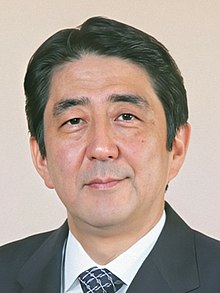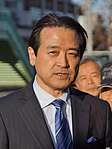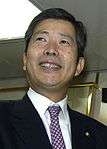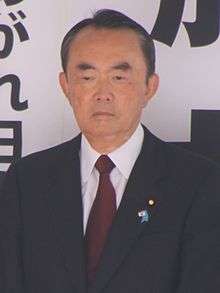2014 Japanese general election
The 47th general election of members of the House of Representatives (第47回衆議院議員総選挙, dai-yonjūnanakai Shūgiin giin sōsenkyo) of Japan was held on 14 December 2014. Voting took place in all Representatives constituencies of Japan including proportional blocks, in order to appoint Members of Diet to seats in the House of Representatives, the lower house of the National Diet of Japan. As the cabinet resigns in the first post-election Diet session after a general House of Representatives election (Constitution, Article 70), the lower house election also led to a new designation election of the prime minister in the Diet (Shinzō Abe was reappointed), and the appointment of a new cabinet (with some ministers re-appointed). The turnout in this election is the lowest in Japanese history.
| ||||||||||||||||||||||||||||||||||||||||||||||||||||||||||||||||||||||||||||||||||||||||||||||||||||||||||||||||||||||||||||||||||
All 475 seats to the House of Representatives of Japan 238 seats needed for a majority | ||||||||||||||||||||||||||||||||||||||||||||||||||||||||||||||||||||||||||||||||||||||||||||||||||||||||||||||||||||||||||||||||||
|---|---|---|---|---|---|---|---|---|---|---|---|---|---|---|---|---|---|---|---|---|---|---|---|---|---|---|---|---|---|---|---|---|---|---|---|---|---|---|---|---|---|---|---|---|---|---|---|---|---|---|---|---|---|---|---|---|---|---|---|---|---|---|---|---|---|---|---|---|---|---|---|---|---|---|---|---|---|---|---|---|---|---|---|---|---|---|---|---|---|---|---|---|---|---|---|---|---|---|---|---|---|---|---|---|---|---|---|---|---|---|---|---|---|---|---|---|---|---|---|---|---|---|---|---|---|---|---|---|---|---|
| Turnout | 52.66% ( | |||||||||||||||||||||||||||||||||||||||||||||||||||||||||||||||||||||||||||||||||||||||||||||||||||||||||||||||||||||||||||||||||
| ||||||||||||||||||||||||||||||||||||||||||||||||||||||||||||||||||||||||||||||||||||||||||||||||||||||||||||||||||||||||||||||||||
.svg.png) Single-member district and PR block seats won by respective parties | ||||||||||||||||||||||||||||||||||||||||||||||||||||||||||||||||||||||||||||||||||||||||||||||||||||||||||||||||||||||||||||||||||
| ||||||||||||||||||||||||||||||||||||||||||||||||||||||||||||||||||||||||||||||||||||||||||||||||||||||||||||||||||||||||||||||||||
 |
|---|
| This article is part of a series on the politics and government of Japan |
|
|
|
|
Background
In 2012, the Democratic Party government under Yoshihiko Noda decided to implement a raise of the Japanese consumption tax. Following this move, the Liberal Democratic Party under Shinzo Abe regained control of the Japanese government in the December 2012 general election. Abe proceeded to implement a series of economic programs known as "Abenomics" in a bid to stimulate the economy. Despite these programs, Japan entered a technical recession in mid-2014, which Abe blamed on the consumption tax hike, even though many members of the LDP supported the hike. Abe called a snap election on November 18, in part for the purpose of winning LDP backing to postpone the hike and pursue the Abenomics package.[1][2]
The LDP government was widely expected to win the election in a landslide, and many observers viewed the snap election as a mechanism for Abe to entrench his government at a time of relative popularity.[3]
Results
The LDP lost a small number of seats but slightly enlarged its majority coalition with Komeito. Turnout was a record low, and many voters viewed the election as a waste of time and money. DPJ president Banri Kaieda lost his seat in Tokyo while the Japanese Communist Party doubled in strength.[4][5] The right-leaning Japan Innovation Party and Party for Future Generations lost seats.[6]
| Political Party | Local Constituency Vote | PR Block Vote | Total Seats | +/− | |||||||||
|---|---|---|---|---|---|---|---|---|---|---|---|---|---|
| Votes[9] | % | Seats | Votes | % | Seats | Total | % | Before | Last | ||||
| Government coalition | 26,226,838 | 49.54% | 232 | 24,973,152 | 46.82% | 94 | 326 | 68.63% | 0 | +1 | |||
| Liberal Democratic Party | LDP | 25,461,448 | 48.1% | 223 | 17,658,916 | 33.11% | 68 | 291 | 61.26% | -4 | -3 | ||
| Komeito | NKP | 765,390 | 1.45% | 9 | 7,314,236 | 13.71% | 26 | 35 | 7.37% | +4 | +4 | ||
| Democratic Party | DPJ | 11,916,849 | 22.51% | 38 | 9,775,991 | 18.33% | 35 | 73 | 15.37% | +10 | +16 | ||
| Innovation Party | JIP | 4,319,645 | 8.16% | 11 | 8,382,699 | 15.72% | 30 | 41 | 8.63% | -1 | New | ||
| Japan Communist Party | JCP | 7,040,130 | 13.3% | 1 | 6,062,962 | 11.37% | 20 | 21 | 4.42% | +13 | +13 | ||
| Party for Future Generations | PFG | 947,395 | 1.79% | 2 | 1,414,919 | 2.65% | 0 | 2 | 0.42% | -17 | New | ||
| Social Democratic Party | SDP | 419,347 | 0.79% | 1 | 1,314,441 | 2.46% | 1 | 2 | 0.42% | 0 | 0 | ||
| People's Life Party | PLP | 514,575 | 0.97% | 2 | 1,028,721 | 1.93% | 0 | 2 | 0.42% | -3 | New | ||
| New Renaissance Party | NRP | - | - | - | 16,597 | 0.03% | 0 | 0 | 0.00% | 0 | 0 | ||
| Others | 43,546 | 0.08% | 0 | 364,965 | 0.69% | 0 | 0 | 0.00% | 0 | 0 | |||
| Independents | 1,511,242 | 2.85% | 8 | – | – | – | 8 | 1.68% | -7 | +3 | |||
| Total | 52,939,789 | 100.00% | 295 | 53,334,447 | 100.00% | 180 | 475 | 100% | -5[10] | - | |||

Notable losses
The most high-profile LDP candidate to lose re-election is Agriculture Minister Koya Nishikawa, who lost by 199 votes (0.2%) to former Governor of Tochigi Akio Fukuda.[11] He was questioned in October after allegedly receiving financial support from a fraudulent company.[12]
Amongst the DPJ members to lose their seats were party leader Banri Kaieda.[13] Party for Future Generations leader Shintaro Ishihara was also unsuccessful in his attempt to win a seat after receiving a low position on his party's representative ballot.[13]
Former leader of the now-dissolved Your Party and six-term representative for Tochigi-3rd district Yoshimi Watanabe was also defeated.[14]
The JCP gained its first single-seat constituency seat since the 1996 election. Amidst a growing anti-base movement in Okinawa, JCP candidate Seiken Akamine unseated LDP incumbent Kōnosuke Kokuba in a night marked with a nationwide JCP surge.[15]
Other elections
Generally, the retention referendum (formally kokumin shinsa, "popular review") to confirm judges of the Supreme Court who have been recently appointed or not confirmed for 10 years is held together with a lower house election.
Subnational elections scheduled for December 14 include the prefectural assembly election in Ibaraki.[16] Another prefectural election in December 2014 is the gubernatorial election in Miyazaki, scheduled for December 21.[17]
Boundary changes
Under 2013 changes to the electoral law designed to reduce malapportionment, district boundaries in 17 prefectures have been redrawn and five districts are eliminated without replacement (one each in Fukui, Yamanashi, Tokushima, Kōchi and Saga). The number of first-past-the-post seats is reduced to 295, the total number of seats decreases to 475.[18]
Constitutionality
In November 2015, the Grand Bench of the Supreme Court ruled that the inequality in vote weight due to malapportionment was still in an unconstitutional state (iken jōtai); however, as in previous such rulings, it dismissed the demand to invalidate the election.[19][20]
Polling
- Parties' approval ratings from 2013–14
(Source: NHK)
| Date | Lead | ||||||||||||||||
|---|---|---|---|---|---|---|---|---|---|---|---|---|---|---|---|---|---|
| LDP | DPJ | JRP | PFG | NKP | YP | PLP | JCP | SDP | GW | NRP | UP | JIP | Other | No Party | Undecided | ||
| 5–7 December | 38.1% | 11.7% | 0.1% | 5.9% | 0.3% | 4.3% | 0.9% | 0.0% | 3.7% | 0.1% | 26.3% | 8.5% | 11.8% | ||||
| 7–9 November | 36.6% | 7.9% | 0.2% | 2.2% | 0.0% | 0.0% | 3.5% | 0.6% | 1.2% | 0.1% | 40.0% | 7.7% | 3.4% | ||||
| 11–13 October | 40.2% | 5.6% | 0.1% | 4.1% | 0.5% | 0.1% | 3.3% | 0.9% | 1.4% | 0.1% | 35.0% | 8.8% | 5.2% | ||||
| 5–7 September | 40.4% | 5.4% | 0.7% | 0.1% | 4.3% | 0.0% | 0.2% | 3.3% | 0.5% | 0.1% | 0.4% | 36.9% | 7.8% | 3.5% | |||
| 8–10 August | 36.7% | 6.4% | 1.0% | 0.3% | 3.0% | 0.2% | 0.3% | 3.2% | 0.7% | 0.0% | 0.0% | 39.4% | 8.8% | 2.7% | |||
| 11–13 July | 34.3% | 4.8% | 1.7% | 3.6% | 0.5% | 0.3% | 3.4% | 0.9% | 0.1% | 0.3% | 42.5% | 7.6% | 8.2% | ||||
| 6–8 June | 36.9% | 5.1% | 1.1% | 4.0% | 0.4% | 0.1% | 2.8% | 0.6% | 0.0% | 0.1% | 42.4% | 6.7% | 5.5% | ||||
| 9–11 May | 41.4% | 5.6% | 1.1% | 3.7% | 0.2% | 0.3% | 2.4% | 0.9% | 0.2% | 0.1% | 37.2% | 6.9% | 4.2% | ||||
| 11–13 April | 38.1% | 7.4% | 1.3% | 3.4% | 0.9% | 0.2% | 3.6% | 0.6% | 0.1% | 0.2% | 37.2% | 5.2% | 0.9% | ||||
| 7–9 March | 38.7% | 6.5% | 1.1% | 2.2% | 0.8% | 0.1% | 3.3% | 0.8% | 0.4% | 0.1% | 40.0% | 5.2% | 1.3% | ||||
| 7–9 February | 36.2% | 5.8% | 1.3% | 3.9% | 1.1% | 0.3% | 3.3% | 1.4% | 0.5% | 0.2% | 41.0% | 5.2% | 4.8% | ||||
| 11–13 January | 40.4% | 5.8% | 1.6% | 2.8% | 0.8% | 0.1% | 1.6% | 0.7% | 0.1% | 0.3% | 40.3% | 5.5% | 0.1% | ||||
| 2014 | |||||||||||||||||
| 6–8 December | 36.7% | 7.8% | 2.1% | 2.8% | 1.2% | 0.2% | 3.1% | 0.6% | 0.0% | 38.7% | 6.8% | 2.0% | |||||
| 8–10 November | 41.9% | 5.2% | 1.8% | 4.4% | 1.9% | 0.3% | 3.3% | 0.4% | 0.3% | 35.1% | 5.6% | 6.8% | |||||
| 12–14 October | 36.1% | 5.2% | 2.1% | 3.8% | 1.2% | 0.2% | 4.0% | 0.5% | 0.3% | 41.8% | 4.9% | 5.7% | |||||
| 6–8 September | 40.3% | 5.5% | 2.2% | 4.4% | 2.1% | 0.0% | 3.2% | 0.7% | 0.2% | 34.6% | 6.8% | 5.7% | |||||
| 9–11 August | 37.9% | 7.3% | 4.6% | 4.6% | 3.2% | 0.2% | 3.5% | 0.8% | 0.9% | 30.8% | 6.2% | 7.1% | |||||
| 5–7 July | 42.5% | 8.0% | 2.7% | 5.3% | 3.1% | 0.5% | 3.7% | 0.9% | 0.1% | 0.0% | 0.3% | 24.5% | 8.4% | 18.0% | |||
| 7–9 June | 41.7% | 5.8% | 1.5% | 5.1% | 1.5% | 0.1% | 2.2% | 0.4% | 0.0% | 0.0% | 0.2% | 34.6% | 7.0% | 7.1% | |||
| 10–12 May | 43.4% | 5.3% | 2.4% | 3.7% | 2.3% | 0.3% | 2.0% | 1.1% | 0.0% | 0.0% | 0.1% | 33.3% | 6.1% | 10.1% | |||
| 5–7 April | 43.6% | 6.1% | 2.1% | 3.7% | 1.3% | 0.4% | 2.0% | 0.7% | 0.0% | 0.0% | 0.1% | 34.5% | 5.6% | 9.1% | |||
| 8–10 March | 40.1% | 7.0% | 3.9% | 4.4% | 3.1% | 0.3% | 2.1% | 0.6% | 0.0% | 0.0% | 0.1% | 31.8% | 6.6% | 8.3% | |||
| 10–12 February | 40.4% | 7.0% | 5.3% | 3.1% | 2.6% | 0.3% | 2.1% | 0.8% | 0.1% | 0.0% | 0.3% | 31.7% | 6.3% | 8.7% | |||
| 12–14 January | 37.8% | 7.6% | 6.5% | 4.0% | 3.7% | 0.5% | 2.7% | 0.8% | 0.0% | 0.0% | 0.3% | 30.8% | 5.4% | 7.0% | |||
| 2013 | |||||||||||||||||
- Cabinet approval/disapproval ratings
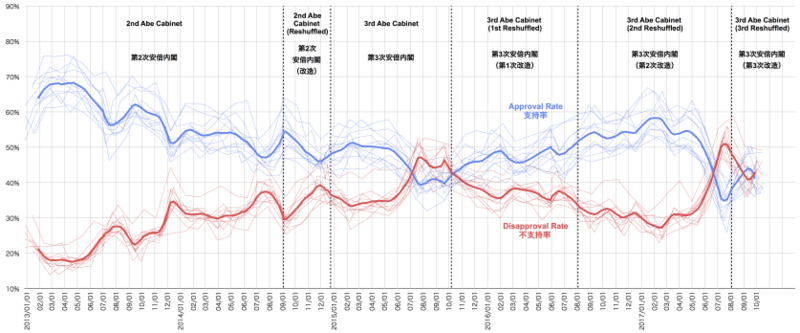
| Date | PM | ||
|---|---|---|---|
| Approval | Disapproval | ||
| 5–7 December | Shinzo Abe | 47% | 38% |
| 7–9 November | Shinzo Abe | 44% | 38% |
| 11–13 October | Shinzo Abe | 52% | 34% |
| 5–7 September | Shinzo Abe | 58% | 28% |
| 8–10 August | Shinzo Abe | 51% | 33% |
| 11–13 July | Shinzo Abe | 47% | 38% |
| 6–8 June | Shinzo Abe | 52% | 32% |
| 9–11 May | Shinzo Abe | 56% | 29% |
| 11–13 April | Shinzo Abe | 52% | 31% |
| 7–9 March | Shinzo Abe | 51% | 30% |
| 7–9 February | Shinzo Abe | 52% | 33% |
| 11–13 January | Shinzo Abe | 54% | 31% |
| 2014 | |||
| 21–22 December[21] | Shinzo Abe | 49% | 34% |
| 6–8 December | Shinzo Abe | 50% | 35% |
| 8–10 November | Shinzo Abe | 60% | 25% |
| 12–14 October | Shinzo Abe | 58% | 26% |
| 6–8 September | Shinzo Abe | 59% | 23% |
| 9–11 August | Shinzo Abe | 57% | 29% |
| 5–7 July | Shinzo Abe | 57% | 25% |
| 7–9 June | Shinzo Abe | 62% | 20% |
| 10–12 May | Shinzo Abe | 65% | 18% |
| 5–7 April | Shinzo Abe | 66% | 19% |
| 23–24 March[22] | Shinzo Abe | 69% | 6% |
| 9–10 March[23] | Shinzo Abe | 76% | 22% |
| 8–10 March | Shinzo Abe | 66% | 18% |
| 10–12 February | Shinzo Abe | 64% | 20% |
| 8–10 February[24] | Shinzo Abe | 71% | 18% |
| 12–14 January | Shinzo Abe | 64% | 22% |
| 11–13 January[24] | Shinzo Abe | 68% | 24% |
| 2013 | |||
References
- Wakatabe, Masazumi. "Election With A Cause: Why Japan's Prime Minister Shinzo Abe Must Call General Election Now". Retrieved 2016-07-14.
- McCurry, Justin (2014-11-18). "Japan calls snap election". the Guardian. Retrieved 2016-07-14.
- Boyd, John. "Japan's unwanted election: Why now?". www.aljazeera.com. Retrieved 2016-07-14.
- "Abe coalition secures big Japan election win with record low turnout". Reuters. 2014-12-15. Retrieved 2016-07-14.
- "Japan election: Voters back Shinzo Abe as PM wins new term - BBC News". Retrieved 2016-07-14.
- "Romping home". The Economist. ISSN 0013-0613. Retrieved 2016-07-14.
- "Ruling coalition wins over 2/3 of seats in lower house election". mainichi.jp. The Mainichi Newspaper (Mainichi Shimbun). Retrieved 14 December 2014.
- "Japan Election / New balance of power in House of Representatives". the-japan-news.com. The Japan News (Yomiuri Shimbun). Retrieved 14 December 2014.
- Decimals from fractional votes (按分票 ambunhyo) rounded to full numbers
- The number of seats reduced from 480 to 475 compared with the last election.
- NHK(Japan Broadcasting Corporation). "NHK2014衆院選". NHK2014衆院選.
- Sukyandaru
- "Abe tightens grip on power as ruling coalition wins 325 seats in Lower House election". The Japan Times.
- "Ex-Your Party leader Watanabe, ex-Tokyo Gov. Ishihara to lose seats". mainichi.jp. Archived from the original on 2014-12-15.
- Aoki, Mizuho (15 December 2014). "Resurgent JCP has night to remember". Japan Times. Retrieved 11 December 2017.
- Ibaraki prefectural election commission: 2014 general election (on the prefectural and municipal levels: ippan-senkyo, 一般選挙, not sō-senkyo as in elections to the national House of Representatives) of members of the prefectural assembly Archived 2014-11-12 at the Wayback Machine (in Japanese)
- Miyazaki prefectural election commission: Schedule for the Miyazaki gubernatorial election Archived 2014-10-18 at the Wayback Machine (in Japanese)
- Ministry of Internal Affairs and Communications: 衆議院小選挙区の区割りの改定等について
- Nihon Keizai Shimbun, November 25, 2015: 14年衆院選、1票の格差は「違憲状態」 最高裁大法廷
- The Japan Times, November 25, 2015: Supreme Court says December election ‘in state of unconstitutionality,’ but won't nullify results
- "Approval rating for Abe Cabinet falls below 50% for 1st time since inauguration: Mainichi poll (in English)". Mainichi Shimbun. 24 December 2013. Archived from the original on 6 January 2014. Retrieved 5 January 2014.
- "【産経・FNN合同世論調査】安倍内閣支持69・6%に上昇 鳩山内閣発足時を超える". MSN産経ニュース. Archived from the original on 2013-03-03. Retrieved 2013-03-24.
- TBS/JNN
- 内閣支持率71%、2回連続上昇...読売世論調査
External links
![]()
